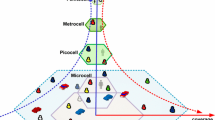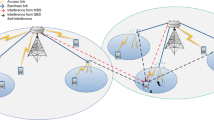Abstract
The heterogeneous network (HetNet) deployed small cells technology in order to overcome the problems of holes “blind spots” coverage in 3G and 4G mobile networks. In this work, we propose a hierarchical HetNet layout comprises of three layers, macro, metro and femto cells. The metro cell is deployed as a backhaul layer in-between macro cell and femto cell layers and operates in a complementary fashion to fulfill handover (HO) traffic interplay between successive layers. Accordingly, the femto cell serves indoor traffic activity of femto users, while metro cell serves the outdoor traffic activities as well as the overflow traffic from femto cells. In addition, in order to reduce the failure probability of femto users handed over to metro cell, a guard channel scheme is employed to prioritize the HO call over new call requests. The highest layer in HetNet, macro cell only serves macro users and the overflowed traffic from the lower layer. Then, we develop a realistic teletraffic model in order to measure the QoS metrics of the proposed HetNet. The numerical results show the capability of HetNet with coexisting small cells to offload traffic from traditional macro cellular network in terms of reducing the blocking probability.











Similar content being viewed by others
References
Ericsson white paper. (2012). Heterogeneous networks, Eircsson, 284 23-3165 Uen February (2012), pp. 1–13. www.ericsson.com/res/docs/WP-Heterogeneous-Networks.
Tang, S., & Li, W. (2006). Modeling and analysis of hierarchical cellular networks with bidirectional overflow and take-back strategies under generally distributed cell residence times. Telecommunication Systems, 32, 71–91. doi:10.1007/s11235-006-8203-1.
Khan, M. A., Ahmet, C. T., Sivrikaya, F., & Albayrak, S. (2012). Cooperation-based resource allocation and call admission for wireless network operators. Telecommunication Systems, 51, 29–41. doi:10.1007/s11235-010-9412-1.
4gamericas.org white paper. (2012). Developing & integrating a high performance HET-NET-4G Americas. http://www.4gamericas.org/documents/4G.
Alcatel-Lucent. (2012). Metro cells: A cost-effective option for meeting growing capacity demands. Alca1tel-Lucent, March, pp. 1–9. http://www.alcatel-lucent.com.
Ghosh, A., Mangalvedhe, N., Ratasuk, R., Mondal, B., Cudak, M., Visotsky, E., et al. (2012). Heterogeneous cellular networks: From theory to practice. IEEE Communications Magazine, 50(6), 54–64.
Landström, S., Furuskär, A., Johansson, K., Falconetti, L., & Kronstedt, F. (2011). Heterogeneous networks-increasing cellular capacity and coverage, Ericsson review 1/2011, pp. 4–9. http://www.ericsson.com/news/110211_hetnets.
John, H., & Payam, M. (2012). Enabling small cell deployment with hetnet. IEEE Wireless Communication, 19(2), 4–5.
Qutqut, M., & Hassanein, H.: (2012). http://research.cs.queensu.ca/TechReports/Reports/2012-590.pdf.
Xu, P., Fang, X., He, R., & Xiang, Z. (2011). An efficient handoff algorithm based on received signal strength and wireless transmission loss in hierarchical cell networks. Telecommunication Systems. doi:10.1007/s11235-011-9667-1, Sept 2011.
Ulvan, A., Bestak, R., & Ulvan, M. (2011). Handover procedure and decision strategy in LTE-based femtocell network. Telecommunication Systems. doi:10.1007/s11235-011-9599-9, Sept. 2011
Lee, S.-Q., Han, R. B., & Park, N.-H. (2011). Call admission control for hybrid access mode femtocell system. In Proceedings of IEEE 7th wireless and mobile computing, networking and communications (WiMob), 2011, pp. 512–516.
Zhang, Y. (2010). Resource sharing of completely closed acces in femtocell networks. Proceedings of the IEEE WCNC, 2010, 1–5.
Luo, J., & Alfa, A. S. (2007). Traffic analysis of heterogeneous mobile cellular networks using “wrap-up” cell structure. Telecommunication Systems, 34, 117–132. doi:10.1007/s11235-007-9036-2.
Karetsos, G. T., Tragos, E. Z., & Tsiropoulos, G. I. (2011). A holistic approach to minimizing handover latency in heterogeneous wireless networking environments. Telecommunication Systems. doi:10.1007/s11235-011-9498-0, June 2011.
Author information
Authors and Affiliations
Corresponding author
Appendices
Appendix A
In this Appendix, we derive the probability \(P_{nc}\), let \(X\) and \(Y\) denote the time duration from an intermediate instant to the border of the metro cell and the time duration from the instant the session starts to the instant the femto user comes to the border of its femto cell. Due to the memoryless property, the random variable \(X\) follows the same exponential distribution with mean \(1/\eta _{m}\). However, due to the FUEs and femto cell are randomly distributed within the metro cell, the time duration \(Y\) is uniformly distributed in \(X\). Then for \(t >0\), the probability density function (pdf) of \(Y\) is given by
By using Mathematica package, the pdf of \(Y\) can be expressed as
where \(\Gamma (a,x)\) is an upper incomplete Gamma function which given by.
Taking Laplace transform of (39), we have
Then the probability \(P_{nc}\) can be expressed as
Appendix B
In this Appendix, we derive the mean value of \(Z,\, E\{Z\}\). The cumulative distribution function of the random variable \(Z\) is given by
The Laplace transform of the CDF \(F_Z (t)\) is given by
The Laplace transform of the pdf of the random variable \(Z\) is given by
Then the mean value of \(Z\) is given by
Rights and permissions
About this article
Cite this article
El-atty, S.M.A., Gharsseldien, Z.M. Backhaul metro cell-based guard channel in femto/macro cellular heterogeneous networks. Telecommun Syst 61, 645–658 (2016). https://doi.org/10.1007/s11235-015-0059-9
Published:
Issue Date:
DOI: https://doi.org/10.1007/s11235-015-0059-9




